Contents
Market Overview
Macro Review
When markets rely on policymakers rather than fundamental economic data. The Fedspeak script became incrementally more dovish last week given comments from Brainard and subsequently Evans and Harker, yet Powell’s chosen words at the WSJ Summit failed to live up to that sentiment. Instead we saw the dollar strengthen 1.4% with rates 13-20bp wider over the week. More worryingly, US 5yr breakevens rose above 2.50% (13yr highs), base metals entered a brief moment of free-fall, while OPEC+ maintained production cuts and allowed Brent and WTI to climb above $68/bbl and $65/bbl, respectively. Under the hood, gold still remains weak and below $1700/oz while copper is back below $9000/t as nickel tumbled 17% after tin fell 11% over the previous week. It remains clearer to market participants that the Fed’s current policy is triggering equity weakness, indeed the drawdown in the Nasdaq 100 breached 10% from the February 12th high (-4.1% this week). The S&P drawdown may only be -4.3% (-1.6% this week), but amid the reflationary narrative the cyclical rotation has come under pressure. More telling, the pain thresholds between the market and the Fed clearly differs and it remains unclear where or when the two interests will align. The market is now-in-waiting as to how the Fed will handle Operation Twist 3.0, Yield Curve Control and the consternation over the SLR exemption as it turns to the March FOMC, while the BoJ has already mooted a wider band and deviating away from its 0% target on 10yr JGBs.
EM Credit Update
EM Credit remains in decompression mode and IG continues to outperform in spread. EM Sovereign Credit ends the week 6bp tighter but down 0.1% overall, while EM Corporate Credit was unchanged in returns after tightening 2bp. At the sovereign-level, Zambia, El Salvador and Sri Lanka outperformed this week, while Ecuador, Tunisia and Suriname lagged. As spreads stand, EM Sovereign IG offers 30bp over US IG, where the EM Sovereign HY pick-up to US HY is 180bp, which remain compelling. We continue to see value in EM over US IG (-3.8% YTD) and US HY (+1.0% YTD).
The Week Ahead
The Fed may be into its blackout period and 3yr/10yr/30yr auctions are likely to be key in terms of clearing the -4.25% repo level on 10yr USTs, but the EM calendar is also picking up. China’s NPC target GDP growth was set above 6% this year, with a CPI target of around 3%, budget deficit of around 3.2% and jobless rate of 5.5%. We will also get the first glimpse of Chinese deflation with the CPI release, followed by M2 which is expected to slow to 9.2%. Central bank rate decisions from Kazakhstan (9.0%) and Peru (0.25%) are unlikely to trigger much interest. However, the main focus of next week is on EM inflation with releases from Argentina, Brazil, Chile, China, Czech Republic, Hungary, India, Mexico, Romania & Taiwan. Beyond that Turkey’s current account deficit data is in focus after the market is beginning to price in rate hikes at the next CBRT meeting on March 18th given that TRY moved up to 7.50.
This week’s emerging markets highlights discussed below include the following: Divergent February PMI data in backdrop of brighter overall global outlook and rising bond yields, Paulo Guedes’ fiscal reform package survives vote in Brazil’s Senate relatively unscathed, keeping odds of Minister’s departure low, Mexico’s Central Bank revised growth and inflation forecasts upward; energy sector developments reflect AMLO’s priorities and support for Pemex, Turkey’s latest inflation dynamics and outlook signal that further monetary policy tightening is needed and Supermajority in El Salvador’s Legislative Assembly by President Bukele’s party points to an improved reform outlook under an increasingly likely IMF program.
Fixed Income
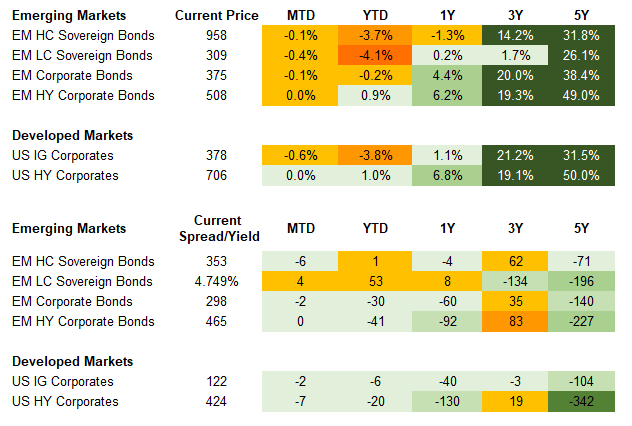
Equities
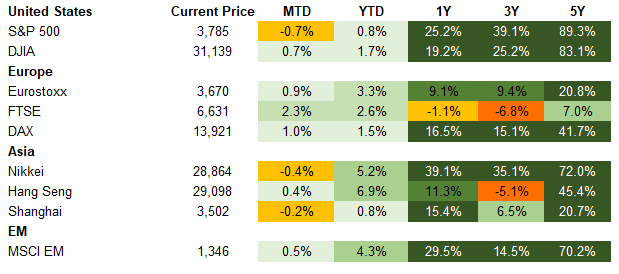
Commodities

Source for data tables: Bloomberg, JPMorgan, Gramercy. EM Fixed Income is represented by the following JPMorgan Indicies: EMBI Global, GBI-EM Global Diversified, CEMBI Broad Diversified and CEMBI Broad High Yield. DM Fixed Income is represented by the JPMorgan JULI Total Return Index and Domestic High Yield Index. Fixed Income, Equity and Commodity data is as of March 5, 2021 (Mid Afternoon).
Emerging Markets Weekly Highlights
Divergent February PMI data in backdrop of brighter overall global outlook and rising bond yields
Event: The global composite February PMI data print increased by 0.9pts to 53.2 following three months of slowing momentum. U.S. data continued to surprise to the upside, particularly in services (0.9pt beat relative to survey expectations), while China composite PMI fell by 0.5pts but remained comfortably expansionary at 51.7. The EU and Japan data improved, but remained in contractionary territory while India, Mexico, and Brazil led gains in EM. Momentum in Colombia, Turkey, and Indonesia declined but levels remained in positive territory.
Gramercy Commentary: Economic activity continues to be in large part driven by respective vaccine penetration and official sector approach and guidance to COVID-19 case management, which partially explains the divergence between the U.S. and China data as well as more broadly. In the U.S., restrictions continue to be lifted while cases drop in contrast to lockdown measures that were in effect for much of February in China. Also, the Lunar New Year holiday typically contributes noise to Chinese February data. Loosening of restrictions in China combined with a roughly 1.5pt increase in order expectations in the services PMI as well as improving external demand should be supportive for growth momentum in the coming months. While policy will gradually tighten in China largely through credit growth, property, and fiscal channels, we do not anticipate official rate increases nor meaningful headwinds to activity. The National People’s Congress and 14th Five Year Plan will be in focus for markets over the week and should provide additional color on the policy and economic agenda.
Paulo Guedes’ fiscal reform package survives vote in Brazil’s Senate relatively unscathed, keeping odds of Minister’s departure low
Event: Brazil’s Senate approved a draft bill allowing the reintroduction of an “emergency stipend” amid the economic fallout from a still deteriorating COVID-19 crisis domestically. The additional budget support for the population is limited to BRL 44bn (around $7.7bn). As counterbalancing fiscal measures, the draft bill establishes so-called “spending cap triggers” to control expenses when obligatory expenditures surpass 95% of total government spending, an important element of Guedes’ agenda to improve Brazil’s stretched fiscal framework. The draft fiscal reforms bill now moves to the lower house for final approval.
Gramercy Commentary: The bill approved by the Senate this week did not depart materially from the core proposals put forward by Paulo Guedes’ economic team. Not crossing any of Guedes’ “red lines” is a relief from a market perspective as it keeps the probability of the reformist “economy tsar”, leaving the embattled Bolsonaro Administration low. For context, Guedes’ orthodox economic policy approach and his liberal reform agenda are drivers of investor confidence and key anchors for the medium term fiscal outlook in Brazil. As we have highlighted previously, strengthening Brazil’s fiscal framework is critical for market confidence going forward. Brazil entered the pandemic in an already weak fiscal position and government finances have been stretched even further by the massive fiscal support (>10% of GDP) deployed to cushion the economy amid the COVID-19 crisis. After the Senate gave its approval, the fiscal reform package now moves to the lower house. It is unclear how long it will take the lower house to discuss and vote on the proposals, but there seems to be enough political momentum for approving the economic team’s package in the near future without material dilution. Meanwhile, deteriorating COVID-19 dynamics domestically are putting additional pressure on the authorities to act swiftly with economic relief measures. Those measures need to be counterbalanced by the reforms championed by Guedes’ economic team in order to assuage market concerns about Brazil’s medium term fiscal outlook.
Mexico’s Central Bank revised growth and inflation forecasts upward; energy sector developments reflect AMLO’s priorities and support for Pemex
Event: Banxico published its 4Q20 inflation report this week where it increased its 2021 growth forecast to 4.8% from 3.3% and lifted headline inflation expectations by 20-30bps to 3.6% by year-end. An electricity bill, which prioritizes CFE services over private companies and increases prospects for contract revision, was approved this week. Meanwhile, Pemex renegotiated an ethane contract with Braskem-Idesa to secure roughly $600mm in cost savings from penalties associated with inability to meet initially agreed upon supply. Additionally, Pemex’s CEO stated that the government will cover the company’s upcoming payments albeit did not provide details of the plan. Lastly, Pemex will no longer have solicited Fitch ratings but the agency will continue to publish research on and rate the entity.
Gramercy Commentary: The improved economic outlook and higher inflation forecasts are now closer to market estimates albeit more optimistic on the growth front. Expectations for core inflation were not changed and thus leave room for an additional rate cut in March, although continuation of recent dynamics in U.S. rates and the Fed meeting on the 17th could put Banxico on hold. While the energy legislation is likely to face legal resistance, its passage is indicative of AMLO’s state company centric strategy particularly related to Pemex as this would allow for greater Pemex fuel oil sales to CFE. We expect the sovereign to continue to back Pemex likely through a combination of approaches including lower taxes, direct capital injections, and liability management exercises to the tune of 1-1.5% of GDP in 2021. This approach optimizes costs in the short run, but the plan remains piecemeal, does not provide a lasting solution, and will continue to weigh on the sovereign’s balance sheet and credit ratings over time.
Turkey’s latest inflation dynamics and outlook signal that further monetary policy tightening is needed
Event: Headline inflation in Turkey accelerated to 15.6% y/y in February, from 15% in January. Meanwhile, recent TRY weakness and higher commodities prices have increased the upside risks to the inflation outlook.
Gramercy Commentary: Given the latest inflation dynamics and outlook, we believe the probability of another rate hike by the CBRT has increased. The authorities need to deliver at least 100bps of tightening at the upcoming policy meeting on March 18th in order to restore an ex-post real interest rate of around 250bps, the minimum buffer that we believe is comfortable for the TRY. At the time of the last hike on December 24th, 2020, ex-post onshore real rates had declined to around 100bps and the CBRT hiked its main policy rate by 200bps to 17%, restoring a 3% real rate buffer. With the latest inflation print of 15.6%, real rates have again eroded, which signals to us that more policy tightening is in order, especially given TRY weakness over the last 2 weeks. As such, the policy meeting on March 18th is shaping up as yet another important market test for the inflation fighting credentials of Governor Agbal and his team as well as the political “carte blanche” to continue with orthodox policy measures. After delivering a world-leading 18% spot rally against the USD between early November 2020 and mid-February 2021, the Lira has given back close to 8% over the last 2 weeks amid broad market risk-off triggered by the sell-off in U.S. Treasuries. A resumption of the TRY rally will be subject to a stabilization of UST rates as, but also the CBRT maintaining its hawkish stance and supporting it by a measured rate hike later this month.
Supermajority in El Salvador’s Legislative Assembly by President Bukele’s party points to an improved reform outlook under an increasingly likely IMF program
Event: President Nayib Bukele’s Nuevas Ideas (NI) party won a historic victory in Parliamentary Elections on February 28th. NI and its allies will control at least 60 of 84 seats in the Legislative Assembly, giving the Bukele Administration a level of governability unprecedented in El Salvador’s modern history.
Gramercy Commentary: Ultimately, the market implications of Bukele’s historic triumph will depend on how the new government uses its extraordinarily strong political mandate to deliver much-needed fiscal consolidation after it assumes office in May. The initial signals have been constructive, including an indication by Finance Minister Alejandro Zelaya in a Reuters interview this week that the government plans to seek a 3-year $1.3bn Extended Fund Facility (EFF) with the IMF. Minister Zelaya also suggested that the authorities see a reform program with the Fund as a “golden opportunity” to revitalize El Salvador’s dollarized economy that has been hit hard by the pandemic. We note that in the event an IMF program materializes, which we believe is highly likely to happen by May/June, the Bukele’s Administration strong governability will greatly facilitate policy implementation capacity, a stark departure from the country’s traditionally dysfunctional political environment. From a market perspective, El Salvador’s global bonds have outperformed materially over the last couple of weeks on increasing investor optimism about IMF prospects in the context of President Bukele’s historic victory in the elections last Sunday. Despite strong recent outperformance, El Salvador remains one of the more interesting HY sovereign opportunities, in our view. We believe it offers room for further spread tightening and still high carry against a backdrop of a constructive event risk anchored by the likely forthcoming IMF program by mid-year.
Emerging Markets Technicals
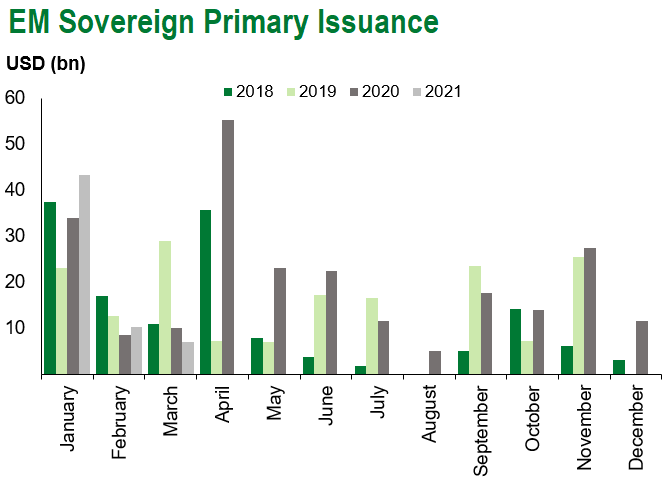
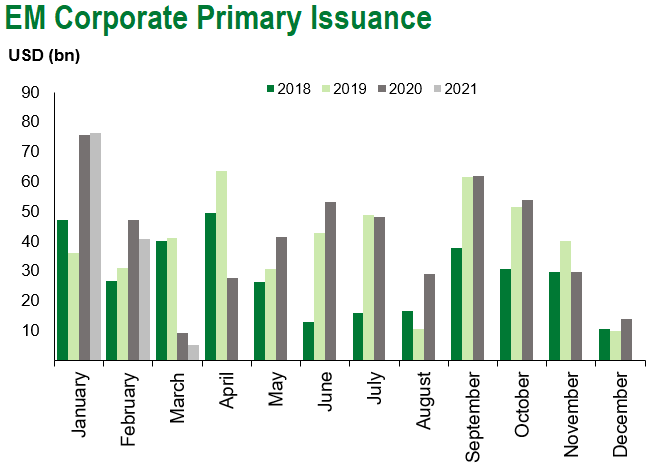
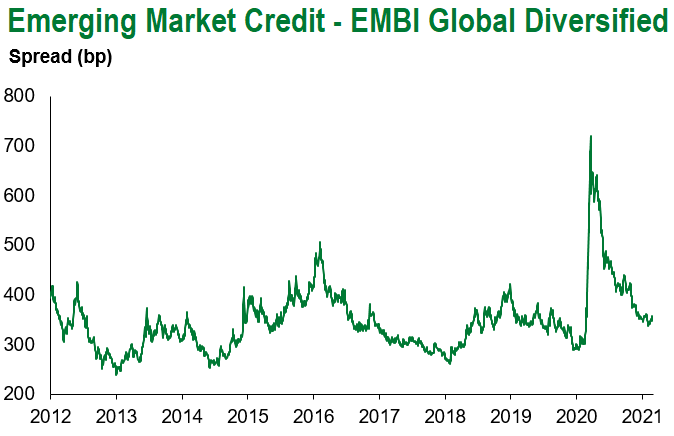
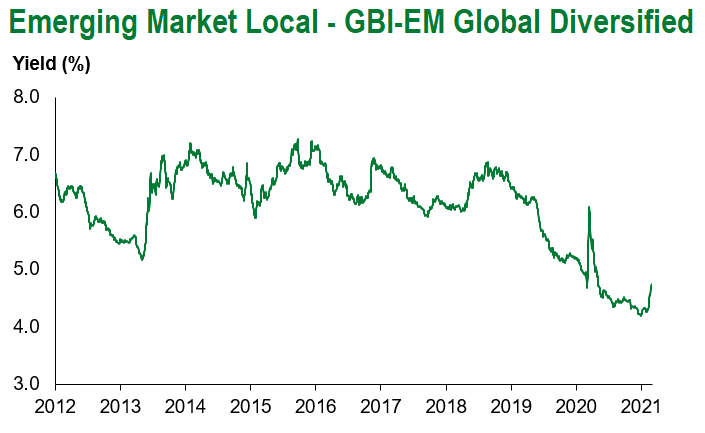
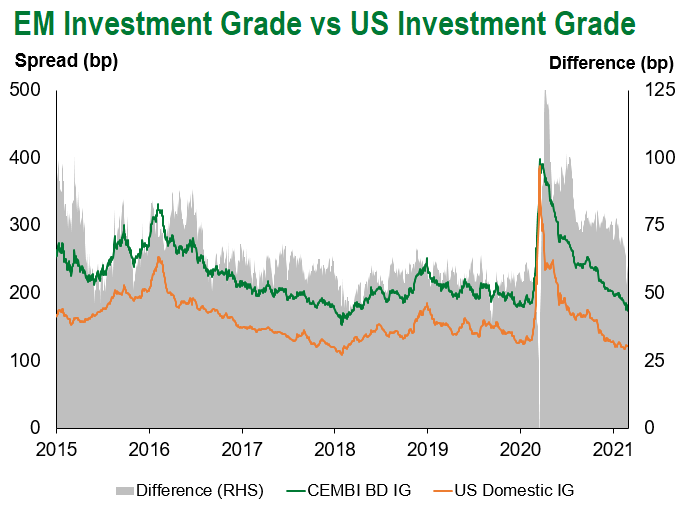
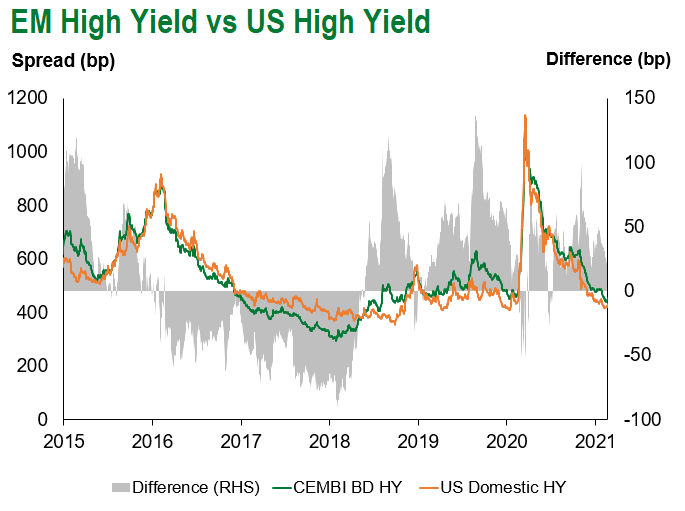
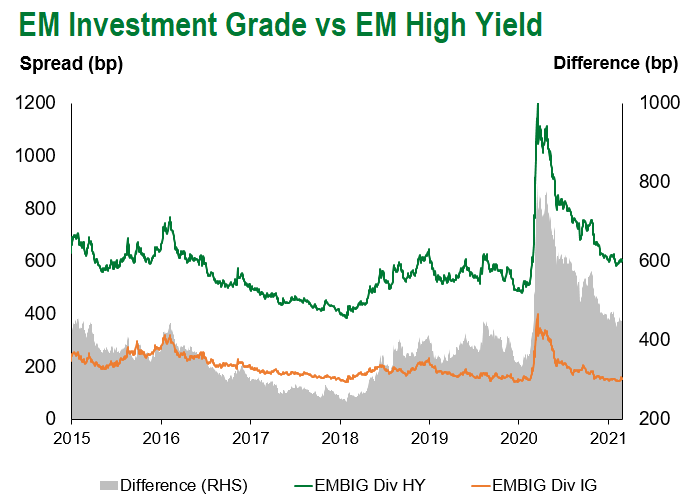
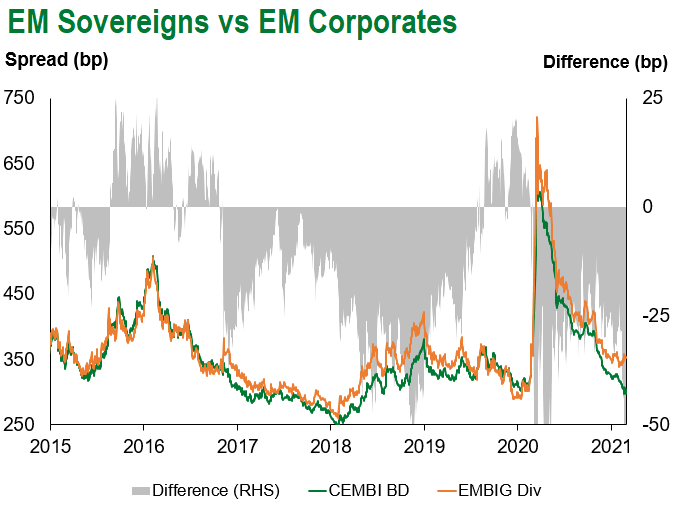
Emerging Markets Flows
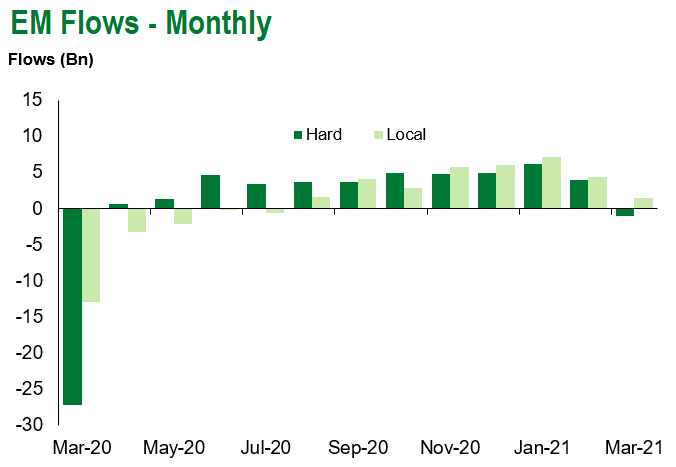
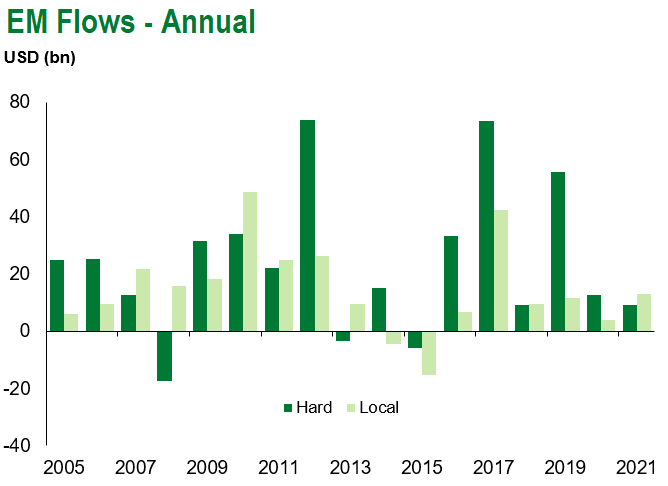
Source for graphs: Bloomberg, JPMorgan, Gramercy. As of March 5, 2021.
COVID Resources
Emerging Markets COVID-19 Case Summary
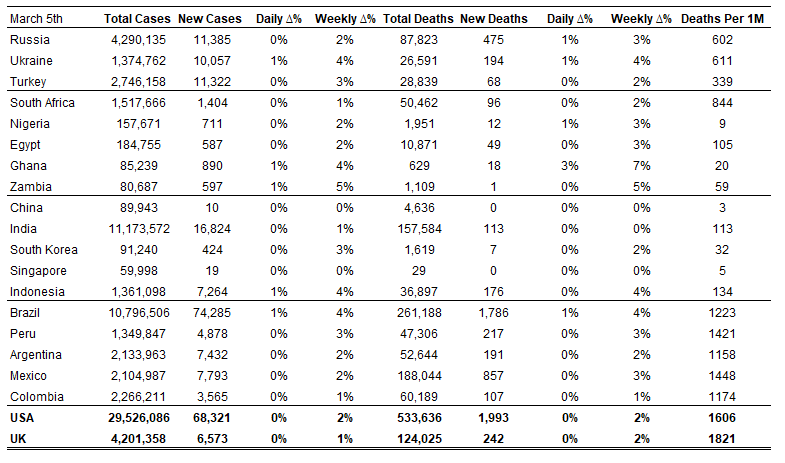
Source: Worldometer as of March 5, 2021.
Additional Crisis Resources:
Johns Hopkins COVID-19 Case Tracker
For questions, please contact:
Kathryn Exum, Senior Vice President, Sovereign Research Analyst, [email protected]
Petar Atanasov, Senior Vice President, Sovereign Research Analyst, [email protected]
Tolu Alamutu,CFA, Senior Vice President, Corporate Research Analyst, [email protected]
James Barry, Vice President, Corporate Research Analyst, [email protected]
This document is for informational purposes only. The information presented is not intended to be relied upon as a forecast, research or investment advice, and is not a recommendation, offer or solicitation to buy or sell any securities or to adopt any investment strategy. Gramercy may have current investment positions in the securities or sovereigns mentioned above. The information and opinions contained in this paper are as of the date of initial publication, derived from proprietary and nonproprietary sources deemed by Gramercy to be reliable, are not necessarily all-inclusive and are not guaranteed as to accuracy. This paper may contain “forward-looking” information that is not purely historical in nature. Such information may include, among other things, projections and forecasts. There is no guarantee that any forecasts made will come to pass. Reliance upon information in this paper is at the sole discretion of the reader. You should not rely on this presentation as the basis upon which to make an investment decision. Investment involves risk. There can be no assurance that investment objectives will be achieved. Investors must be prepared to bear the risk of a total loss of their investment. These risks are often heightened for investments in emerging/developing markets or smaller capital markets. International investing involves risks, including risks related to foreign currency, limited liquidity, less government regulation, and the possibility of substantial volatility due to adverse political, economic or other developments. The information provided herein is neither tax nor legal advice. Investors should speak to their tax professional for specific information regarding their tax situation.